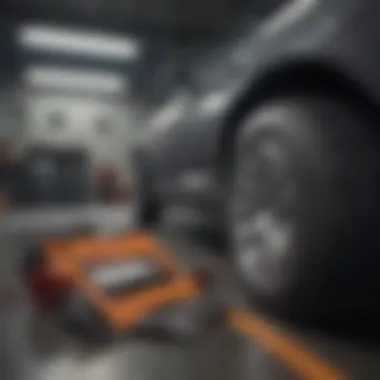Understanding Vehicle Inspection Costs: Key Factors Explained


Intro
Understanding the costs involved in vehicle inspections is essential for every vehicle owner. This process involves various aspects, including pricing, regulations, and types of inspections. By diving deeply into each of these factors, we can uncover what influences the overall costs and ultimately aid vehicle owners in their decision-making.
Before examining these costs in detail, it is important to acknowledge that prices can fluctuate significantly based on several variables such as geographic location, the specific type of inspection required, and local regulations. Being informed about these factors prepares owners for any necessary expenses that come with maintaining their vehicles in good condition.
Through this article, we address the common misunderstandings around vehicle inspection costs. Understanding what drives these costs can empower vehicle owners, ensuring compliance with local laws while simultaneously guaranteeing vehicle safety for themselves and others on the road.
Key Factors Influencing Vehicle Inspection Costs
The costs of vehicle inspections range widely inside and outside the U.S. Knowing the basics about this cost structure helps owners budget properly and make informed choices about their vehicle care.
Type of Inspections
- Safety Inspections: Many states require these to ensure that basic safety components function correctly. These typically carry a lower cost since they usually involve basic checks such as brakes, lights, and tires.
- Emissions Testing: In regions where environmental laws are strict, this test is essential to verify that vehicles comply with emissions regulations. The costs involved can be higher compared to safety inspections because of the complexity of the tests.
- Pre-purchase Inspections: Potential buyers often have an expert examine a used vehicle, which gives additional peace of mind. Fees can vary depending on the inspection depth.
State Regulations
Different states set varied requirements for vehicle inspections, which affects associated costs. Some states, for instance, may include inspection fees in their vehicle registration costs, while others charge separately. Certain states even waive inspection fees or offer discounts, depending on specific situations.
Regional Differences
Factors influencing costs also include the local market dynamics. Urban areas may have higher inspection prices due to increased overhead costs for service providers. In contrast, rural areas may offer more competitive pricing.
Additional Expenses
Always consider potential extra costs such as repairs that could arise if your vehicle fails an inspection. Understanding that these potential extra expenses are a part of the process can help make readiness at the time of inspection easier.
When undergoing a vehicle inspection, being prepared financially makes the experience less stressful and more manageable.
By unpacking the broad topic of vehicle inspection costs, we set a foundation for looking deeper into each specific aspects and shine a light on practical realities for current and new vehicle owners. Understanding these can ease anxiety and instill a proactive approach toward compliant ownership.
Overview of Vehicle Inspections
Vehicle inspections serve as a crucial mechanism to ensure that cars on the road adhere to established safety and environmental standards. Understanding vehicle inspections is not just beneficial; it is essential for vehicle owners. With ever-increasing traffic and more stringent regulations, knowing what inspections entail helps mitigate risk and ensure compliance with laws.
Purpose of Vehicle Inspections
The primary purpose of vehicle inspections is to safeguard public safety. By assessing various components of a vehicle, the inspections aim to catch potential hazards before they escalate into serious issues. Furthermore, many states implement inspections to uphold environmental standards, reducing pollutants and harmful emissions from vehicles. This emphasizes a societal interest in not only safeguarding individuals but also in protecting our shared environment.
Regularly scheduled inspections uncover problems with braking systems, lights, tires, and emissions controls. In short, they enhance road safety and contribute to decreasing accident rates. Keeping that context, it is clear that consistent vehicle inspections manifest multiple benefits that stretch beyond mere compliance. They can ultimately affect insurance costs, enhancing overall savings for drivers.
Types of Vehicle Inspections
Each vehicle inspection serves different yet vital differents objectives, catering to unique needs. The variations can be categorized mainly into three types: safety inspections, emissions inspections, and comprehensive inspections. Each type plays a distinct role that contributes to the development of vehicle oversight.
Safety Inspections
Safety inspections strive to ensure that a vehicle operates safely and reliably. This type usually covers fundamental components like brakes, steering, and tires. A key characteristic of safety inspections is their focus on essential systems necessary for safe driving. They are common in many states and thus can be valued for their relevance in preventing accidents due to vehicle malfunction. Moreover, while very useful, conflicting regulations among states throw complexity into the inspections.
One uniquess feature of safety inspections is that they usually alert vehicle owners to problems before they result in larger repairs. However, it is also worth noting that passing a safety inspection does not guarantee that a vehicle is free of minor unresolved issues. Still, they are a popular choice among proactive vehicle owners.
Emissions Inspections
Emissions inspections non the less focus primarily on the environmental impact of a vehicle. This type mainly checks to ensure that vehicles meet prescribed emissions levels as established by local or federal regulations. A noteworthy aspect is that many urban areas mandate emissions tests to control pollution levels effectively. In addition, these inspections typically involve a diagnosis of a vehicle's exhaust systems and catalytic converter efficiency.
The distinct feature regarding emissions inspections is that a vehicle must meet specific standards relevant to its make and model. This may lead to unexpected costs for vehicle owners needing repairs to comply with environmental regulations. In addition to promoting cleaner air, emissions tests raise awareness about maintenance related to engine performance.


Furthermore, if an owner neglects necessary repairs addressing emissions warnings from the vehicle, there are disadvantages that develop, such as incurred fines and possibly disqualified registration.
Comprehensive Inspections
In contrast to the other inspection types, comprehensive inspections encompass a broader analysis of a vehicle. This thorough assessment checks not only the safety fundamentals but also includes evaluations of interior components, other systems, and fluid levels. The term embodies situational adaptability. Unlike more basic safety checks, it solutions larger concerns.
Their key characterisitce involves a holistic review that can initially seem overwhelming for some but ultimately reassures vehicle owners of thorough maintenance practices. A major advantage of comprehensive inspections reflects an enhanced overall understanding of vehicle condition and upcoming maintenance requirements, proactively preventing breakdowns.
In summary, vehicle inspections exist to provide crucial oversight into the operational capacity and compliance of vehicles, thus ensuring a safe, structured driving environment for all. Understanding their types and objectives can arguably simplify the stewardship of users' invaluable transportation assets.
Importance of Regular Inspections
Regular vehicle inspections play an indispensable role in ensuring vehicle longevity and maintainence efficiency. Establishing a proactive habit for car inspections not only nouruses a heightened awareness towards vehicle condition but routinely deters larger issues from arising. Being accountable in an area often leading to public safety has merits that extend into communities’ collective well-being; civic responsibility reflects meaningful participation in societal health and safety. Maintaining routines of consistent inspections reveals long-term advantages that echo through personal safety, cost savings, and environmental consciousness.
Factors Influencing Inspection Costs
Understanding the factors influencing vehicle inspection costs is crucial for every vehicle owner. The effort to know these elements may seem tedious, however, it can lead to saving money over time and ensuring better compliance with both safety and environmental standards. A thorough comprehension of these factors not only helps gauge how much to expect in terms of expenditure but also prepares the owner for potential future costs.
Geographic Variations
The location plays a significant role in inspection costs. Different regions or states impose various regulations that can influence the pricing of inspections. Some states have strict emission laws, thus the inspection expenses can be higher. In contrast, in areas with fewer regulations, the costs tend to be lower. It's essential for owners to understand the local laws and expenses while considering vehicle inspections. This geographical aspect can dramatically alter overall expenditure.
Type of Vehicle
The kind of vehicle also impacts inspection pricing. Different vehicles require different levels of inspection. For instance, a standard passenger car generally incurs lower inspection costs than a heavy-duty truck. Likewise, luxury or high-performance vehicles might have specific requirements which can increase inspection fees. The owner needs to be aware of these variances to budget adequately for inspection costs associated with their specific vehicle type.
Condition of the Vehicle
The existing condition of the vehicle significantly influences inspection expenses. If a vehicle shows signs of wear or requires repairs before an inspection, the costs can arise substantially. Inspectors charge fees based on what work may be needed to ensure compliance with safety and emissions regulations. Thus, maintaining the vehicle in a good working order can alleviate heightened inspection costs. Regular maintenance should thus be a priority to keep expenses controlled at the inspection phase.
Inspection Facility Type
Government vs.
Private
When it comes to the type of inspection facility, both government and private facilities offer vehicle inspection services, each contributing different factors to the overall costs. Government-run inspection facilities usually host standard procedures that often remain less expensive. However, the criteria may be more rigid, offering assurance of performace. Private facilities, on the other hand, may offer premium services at a higher cost. This choice depends on individual predilections between affordability or more personalized, flexible service offerings. Hence, selecting the appropriate facility is crucial, which can affect the overall expense significantly.
Certification Levels
Certification levels at inspection facilities can also differ, influencing the cost. Facilities with higher certification standards often possess better equipment and trained staff. These facilities tend to charge more due to the excellence and level of service delivered. Conversely, less specialized facilities might seem cheaper, yet they could compromise on thoroughness or outcomes. It's vital to appreciate how these certification levels contribute towards the inspection costs directly affecting quality and performance of vehicle assessments.
Average Costs Associated with Vehicle Inspections
Understanding the average costs associated with vehicle inspections is essential for vehicle owners. Inspections do not just help maintain vehicle safety; they also ensure compliance with local laws. From a financial perspective, knowing these averages provides insight into what one might expect to invest.
Considering the average costs can assist individuals in budgeting effectively. The examination of costs entails both national averages and state-specific variations, enabling a comprehensive perspective not just within a specific locality, but across the country. Moreover, a cost breakdown based on different inspection types sheds light on how distinct variables impact the total cost for vehicle inspections.
National Averages
National averages offer a baseline understanding regarding vehicle inspection costs across the country. These averages can fluctuate significantly based on various regions and their corresponding legislation. Understanding this figure enable consumers to align their expectations with reality.
Generally, the national average for typical safety inspections ranges widely – hovever, it is crucial to remember that these numbers can be misleading if understood without local context. They provide an initial framework but real-world factors like individual state regulations must be taken into account. Owning a car in Virginia, for example, might introduce certain particular expenses that owning the same in California does not.
State-Specific Averages
State-specific averages reveal more nuanced insights into vehicle inspection costs. States regulate their own vehicle safety and emissions standards, which consequently impacts average pricing considerably. For instance, states with stricter environmental regulations may mandate higher fees for emissions testing and thus, translate to elevated overall inspection prices.


Being aware of state-specific averages is advantageous. It equips vehicle owners with the know-how of what to expect and facilitates financial planning or engagemnt with numerous inspection facilities. In this way, understanding the financial implications quite well aids in communicative dealings while remaining compliant.
Cost Breakdown by Inspection Type
Understanding the distinct costs associated with various inspections is crucial, as each type serves different purposes.
Safety Inspections
Safety inspections are typically mandatory in most states. Their primary aim is to ensure that vehicles meet essential safety criteria necessary to be on the road. The results of safety inspections often dictate whether further action or repairs are needed.
The affordability of safety inspections make them a highly beneficial choice for those concerned about basic vehicle health. In general, the costs range from $10 to $30.Vehicles passing these anyone be ensured of their essential operability on the road.
Some unique features of safety inspections include a check for functioning lights, brakes, and effective tires. Together, these inspections meet regulatory requiremants while simultaneously ensuring essential public safety. Despite its advantages, these inspections might lack comprehensiveness when it comes to inherently underlying issues.
Emissions Testing
Emissions testing plays a pivotal role in North America as many states require this type of inspection to ensure vehicles are not contributing excessive pollutants. Costs for emissions testing also vary but often range between $15 and $50, making it a primary state-mandated expense for drivers, if applicable.
Emissions testing ensures gas-burning vehicles operate within specific environmental regulations. Their key characterisitc is direct alignment with city or state commitments to reducing carbon footprints. However, rigorous emissions testing can potentially unveil costly repairs if major failures emerge during diagnostics.
Comprehensive Assessments
Comprehensive assessments encompass both safety inspections and emissions testing. Alongside these, they provide detailed evaluations regarding a vehicle’s overall condition, including engine performance and integrity. These inspections often range from $50 to $100, marking a significant investment but benefiting assurances on vehicle durability.
The most notable aspect of comprehensive assessments are their thorough evaluations. This results in identification of concerns that a basic inspection may miss. This drives added value as vehicle repairs might otherwise grow costly making these inspections réduire overall long-term expenses.
Comprehensive assessments help in spotting issues, efficiently controlling future costs.
Acknowledging the average costs may inescapably lead to having the owner well-prepared for upcoming inspections. Prior understanding ultimately empowers the individuals to kanage their resources effectively. Evolving understanding of these costs results in educated decisions and improved readiness for vehicle ownership.
Additional Costs Beyond Inspection Fees
The topic of additional costs beyond inspection fees is critical in understanding the overall financial impact related to vehicle inspections. When owners budget for an inspection, they often focus only on the base fee. However, potential extra expenses can accumulate rapidly and need attention. Gaining insight into these possible costs allows vehicle owners to adequately prepare their finances and avoid surprises. It emphasizes the importance of being proactive and tech-wise in managing vehicle health and compliance.
Potential Repairs and Maintenance
Often, after a vehicle inspection, the technician may highlight issues that require immediate repair to meet safety precincts or emissions standards. The cost for these repairs can range widely. Simple fixes like replacing bulbs or wiper blades might be fairly inexpensive, while more significant repairs such as exhaust system replacements can be hefty. Performing routine maintenance, like oil changes or fluid checks, before inspections can prevent major findings that would otherwise lead to expensive repairs. Some benefits of considering these repairs include:
- Meeting Compliance: Ensuring vehicle compliance is crucial for legal road worthiness.
- Safety Enhancements: Addressing issues leads to better safety for the driver and passengers.
- Long-term Savings: BIMaintained vehicles more likely to withstand the test of time hence reducing eventual cumulative repair costs.
Re-testing Fees
After initial vehicle inspections, some vehicles might require re-testing to ensure that repairs adequately addressed worn faults or failures noted in the prior inspection. This re-testing often carries an additional fee, typically lesser than the original inspection cost but still making a notable impact on the overall budget. Timing can play a role in fees; many facilities offer different rates depending on how quickly a vehicle returns. Important considerations regarding re-testing include:
- Retention of Records: Keeping copies of previous inspection results is vital to assist in future retests.
- Demonstration of Compliance: Failing a test may necessitate a re-examination which not only affects fees but potentially affects insurance rates.
- Possible Discounts: Inquire whether facilities offer consolidated pricing if both inspections and re-tests are done in close succession.
Documentation and Administrative Costs
There are often paperwork and administration fees connected to the vehicle inspection process that can add to the total cost. While these fees are generally nominal, they contribute a bit to the overall spending. Examples may include emissions certificates or documentation of past repairs submitted for future inspections. Awareness of these costs fosters necessary budgeting awareness. Key takeaways about documentation costs include:
- Budget Allocation: Setting aside a budget for paper work enables smoother processes at inspection time.
- Streamlined Processes: Electronic records can minimize misinformation or delays, alleviating added scrutiny or future costs.
- Local Requirements: Each state may impose differing regulations, which could lead to various documentation needs across jurisdictions.
By understanding these additional costs, vehicle owners can develop better preparation strategies, which contributes not only to compliance but also to financial efficiency.
Regulatory Influence on Inspection Costs
The discussion on vehicle inspection costs cannot overlook the significant role that regulations and laws play in shaping these expenses. Regulatory bodies are often responsible for enforcing rules about vehicle safety and environmental compliance. As such, inspections can vary greatly depending on individual state requirements and vehiucle types. Understanding these regulations not only helps in anticipating costs but also ensures compliance. There is also an argument that stricter regulations need consideration as more expensive inspections could prevent unsafe or polluting vehicles from being on the roads.


State Regulations and Mandates
Each state in the United States has its own set of vehicle inspection laws. These laws dictate the frequency, types of inspections required, and associated fees. States like California and New York are known for having stringent emissions testing, which invariably affects the cost of inspections. Alternatively, states with fewer regulations may have lower fees but might not ensure vehicle safety as effectively.
Several factors are considered in these regulations, including:
- Geographical location: Urban areas may impose stricter inspections than rural areas due to congestion and pollution concerns.
- Environmental policies: The focus on reducing emissions leads to additional testing fees targeted at identifying harmful emissions.
- Safety standards: Some states mandate more frequent checks for safety features, adding to the overall cost.
Ultimately, it is vital for vehicle owners to be aware of their state's particular regulations to avoid unexpected costs at inspections.
Impact of Local Governance
Local governance can significantly influence vehicle inspection costs. While states provide the framework, counties or municipalities may impose taxes and additional fees that can raise the cost of inspections even further. For instance, a county may mandate local inspections or certifications, unique to its requirements.
- Different counties may offer different inspection services at varying prices, resulting from competition between inspection facilities or specific mandates.
- City ordinances can lead to enhancements in local inspection demands, such as requiring additional uses for hybrids or electric vehicles. This could elevate costs overall for all vehicles otherwise prone to lower fees under state law.
Understanding local changes is essential for vehicle owners to get accurate estimations on costs and to potentially find more affordable inspection options.
Changes in Legislation
Laws regarding vehicle inspections can change significantly due to legislation. Newly enacted laws or amendments to existing ones can lead to increased costs or extensions on grace periods for inspections. For example, an uptick in vehicle use or safety incidents sometimes results in lawmakers calling for tougher inspections.
Owners must monitor potential changes to vehicle inspection laws or stay informed of upcoming changes. To illustrate; changes can entail:
- Enhanced requirements for emissions testing, leading to raised inspection fees.
- Specifics in documentation or processes required during inspections to ensure more efficient processing which could add to initial costs.
Staying informed about local and state changes in legislation can protect vehicle owners from unwelcome surprises when they arrive at the inspection facility.
Tips for Minimizing Vehicle Inspection Costs
Reducing the financial burden of vehicle inspections can benefit owners significantly. While inspections are necessary for safety and compliance, reducing these costs is an intelligent strategy for every vehicle owner. Being informed enables smarter choices with regard to inspections and upkeep.
Choosing the Right Inspection Facility
The type of inspection facility you choose plays an essential role in the cost. Private facilities typically charge more than government ones, but the service may vary. Research is crucial. Look for reputable locations that offer competitive rates. Reading customer reviews can provide insight into their satisfaction levels. When you have several candidates, ask for quotes. This gives you a clearer financial perspective. The cheapest option is not always the best. Inquire about qualifications and experience before making a decision.
Maintaining Regular Vehicle Maintenance
Regular maintenance is key to preventing severe issues that could otherwise arise. Small repairs before an inspection could make all the difference. Prioritize oil changes, brake checks, and tires regularly. This can spare owners from finding more prominent problems revealed during inspections. Proper care can lead to smoother inspections and lower costs. Take a log of your maintenance if your vehicle inspections rely on ongoing compliance. This history may help you negotiate better rates based on the vehicle's steady upkeep.
Seeking Discounts and Programs
Many facilities offer programs that can help reduce costs. Some might have partnerships with local businesses; taking advantage of these programs could yield significant savings. Check for any discounts available for certain demographic groups or memberships. Students, seniors, and veterans may find applicable reductions. Always ask about promotions at repeated visits. Additionally, searching online gives a view into potential discount sites or codes that are worth exploring. You might be surprised at the savings available.
Exploring various inspection facilities, maintaining vehicles promptly, and seeking discounts not only resourcefully lowers costs but also reinforces safety measures through regulation compliance.
Culmination: Navigating Vehicle Inspection Costs
The discussion in this article covers areas from types of inspections to regulatory influences. Leaning on tgis understanding aids vehicle owners in budgeting properly. It also helps in knowing what to expect when time comes for inspections. Key insights lead to better management of vehicle upkeep.
Summary of Key Points
The article presented a clear picture of what to know when it comes to vehicle inspection costs. Here are essential takeaways:
- Purpose of Inspections: Keeping vehicles safe and compliant with legal standards.
- Types of Inspections: Mainly includes safety, emissions, and comprehensive inspections.
- Influencing Factors: Geographic location, type and condition of vehicles. The facility type also makes a difference.
- Average Costs: These vary by geographical area and nature of inspection.
- Additional Costs: Accurate understanding of what can be considered beyond the initial fees is crucial for planning.
- Regulatory Impacts: Different states enforce varied mandates that can drive inspection costs.
By considering these points, readers can better foresee the possible expenses related to both immediate and future inspections as well as associated needs.
Final Thoughts on Vehicle Inspections
In the end, vehicle inspections shouldn't create anxiety in owners. Rather, they are an opportunity for safeguarding interests. Investing in regular inspections may save money. It could prevent more significant issues later on. Understanding these costs fosters compliance, safety, and responsibilities of ownership. Vehicle maintenance should be proactive, integrating affordable inspections into regular upkeep. Owning a vehicle means anticipating needs, ensuring timely compliance isn’t just about the law. It’s about fostering a long-term relationship with your vehicle.
With diligent care and awareness, navigating the cost of inspections can be straightforward. Be it choosing qualified garages to maintaining your car regularly, there are pathways that promise guidance. Minimize worries by staying informed and proactively caring for your vehicle.







